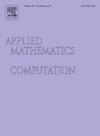基于极坐标法的状态相关切换规则设计:一种混合不稳定子系统组成实例
IF 3.4
2区 数学
Q1 MATHEMATICS, APPLIED
引用次数: 0
摘要
本文研究了具有三种类型的混合不稳定子系统的切换系统:焦点-节点、焦点-鞍和节点-鞍组合。目标是开发合适的状态相关切换规则,以实现系统状态对原点的快速渐近稳定。所提出的交换规则设计遵循三个主要步骤。首先,在极坐标下对每个子系统进行重新表述。通过分析径向距离对极角的导数,建立了径向增量积分准则,量化了系统在旋转和抖振切换机制下的收敛行为。其次,深入分析了不同不稳定子系统组合的内在特征。基于轨迹间的相对运动,进行了相平面区域划分和相轨迹切换分析。最后,利用分系统相轨迹的动态特性,选择最合适的切换机构,充分发挥各分系统的优势。然后通过比较各主动式子系统在各交换机制下的收敛效益,确定相应的交换线路。仿真结果表明,所提出的状态依赖切换策略在降低保守性的同时显著提高了切换系统的收敛速度。本文章由计算机程序翻译,如有差异,请以英文原文为准。
State-dependent switching rule design based on polar coordinate method: A case of hybrid unstable subsystem composition
This article investigates switched systems with three types of hybrid unstable subsystems: focus–node, focus–saddle, and node–saddle combinations. The objective is to develop suitable state-dependent switching rules to achieve rapid asymptotic stabilization of the system state to the origin. The proposed switching rule design follows three main steps. First, each subsystem is reformulated in polar coordinates. By analyzing the derivative of the radial distance with respect to the polar angle, a radial increment integral criterion is established to quantify system convergence behavior under both rotational and chattering switching mechanisms. Second, an in-depth analysis is conducted on the intrinsic characteristics of different unstable subsystem combinations. Region partitioning of the phase plane and switching analysis of phase trajectories are carried out based on the relative motion among trajectories. Finally, by leveraging the dynamic properties of subsystem phase trajectories, the most suitable switching mechanism is selected to fully utilize the advantageous features of each subsystem. The corresponding switching lines are then determined by comparing the convergence benefits of the active subsystems under each switching mechanism. Simulation results demonstrate that the resulting state-dependent switching strategy significantly improves convergence rate of the switched system while reducing conservatism.
求助全文
通过发布文献求助,成功后即可免费获取论文全文。
去求助
来源期刊
CiteScore
7.90
自引率
10.00%
发文量
755
审稿时长
36 days
期刊介绍:
Applied Mathematics and Computation addresses work at the interface between applied mathematics, numerical computation, and applications of systems – oriented ideas to the physical, biological, social, and behavioral sciences, and emphasizes papers of a computational nature focusing on new algorithms, their analysis and numerical results.
In addition to presenting research papers, Applied Mathematics and Computation publishes review articles and single–topics issues.

 求助内容:
求助内容: 应助结果提醒方式:
应助结果提醒方式:


